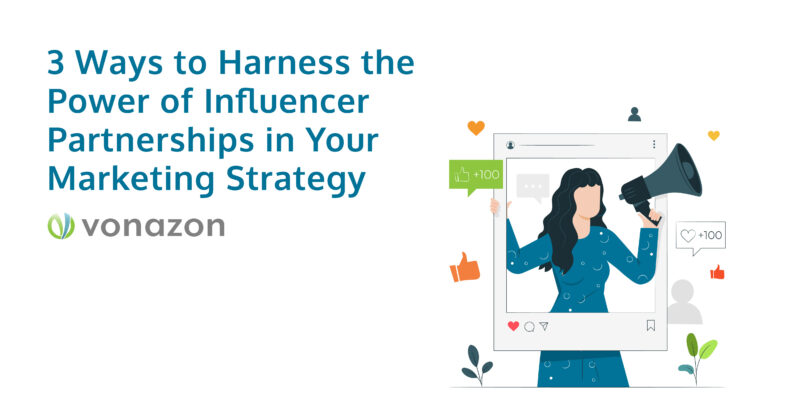
3 Ways to Harness the Power of Influencer Partnerships i n Your Marketing Strategy
As the internet weaves into every part of our daily lives, unexpected marketing opportunities, like influencer partnerships, are taking the world by storm. Traditional marketing methods that were effective with Baby Boomers and Gen X aren’t resonating with newer generations anymore, and companies are now pivoting from the old way of doing things to stay relevant to the times.
Influencer partnerships have quickly evolved into the one number-way brands are choosing to engage with newer audiences.
What are influencer partnerships?
Influencer partnerships are a marketing strategy that establishes relationships with social media personalities and popular content creators, known as influencers. These individuals have sway over different consumer communities and can help shape consumer buying habits. Influencers accomplish this through creative content such as photos, videos, unboxings, and product reviews.
In this blog, we’ll take you through how to build influencer partnerships, where to find popular influencers, and how you can implement influencer marketing best practices to stay relevant among younger audiences and increase your marketing ROI.
How do influencers fit into your marketing strategy?
The common misconception about influencer partnerships is that influencer marketing begins and ends at brand awareness. Many companies experience a disconnect between what the brand wants and how it structures the campaign around its influencer. An influencer’s actual value to your marketing campaign extends past simple consumer reach and likes on social media. To maximize your campaign’s success, your marketing strategy needs to be business goal orientated.
It doesn’t matter if the goal is to raise the number of downloaded apps, increase traffic on the website, get a product in front of a consumer, or even generate more foot traffic at store locations. A well-designed influencer strategy, which incorporates multiple aspects of digital and traditional marketing, will help you achieve those business goals.
Target the correct influencer platform
With an overabundance of conflicting social media platforms, knowing which is the correct app for your business is sometimes difficult. Consumers relate more to people they view as “just like me” than they do with corporations. 90% of consumers, primarily Millennials and Gen Z, crave more personal, authentic content from people they know and follow. As a result, most marketers run influencer campaigns on Instagram.
Marketers rely on a few key factors when building influencer partnerships. As mentioned, the first step is to create a clear set of goals. Every social platform has features for developing diverse content, and focusing on your brand’s campaign objectives will narrow down your choice. The second step is knowing your target audience. Social media apps have unique audience types. Analyzing which culture aligns with your products and services will determine what app you should select. The final step is to track your competition and which platforms they use for marketing. Today several brands compete for market space on social media; companies will need to decide if a densely populated platform is worth the financial commitment.
Here is a brief breakdown of the existing competition in influencer marketing and the percentage of apps used by brands in influencer campaigns:
Instagram (67%), YouTube (36%), TikTok (42%), Twitter (15%), Facebook (43%)

How to identify the perfect influencer partner
Finding the perfect brand ambassador is tricky. Initially, when influencers began to appear in marketing, most organizations assumed the largest audiences would result in the best ROI. That was a misunderstanding. Marketers now look at the audience engagement levels that drive ROI in influencer viewership.
The first step is educating your brand on the five types of influencers. Your campaign must plan around financial challenges relating to these specific influencer tiers. Nano tier (0 to 10k followers) is the first level, followed by Micro tier (10k to 100k followers), then Mid-tier (100k to 500k followers), next is Macro tier (500k to 1M followers), and finally the Mega Macro tier (1M+ followers). Engagement rates spike higher with nano or micro influencers than they do with larger influencers.
Step two involves examining the influencer. Your partner must be able to meet the objectives of your campaign. Can this influencer create content that supports brand messaging without sounding phony? Is this influencer adept at using your chosen platform? Does this influencer’s audience engage their content or merely view their posts? Instagram and TikTok are popular among younger generations, accounting for 40% of smartphone use—meaning short reel videos pair well for product launches. YouTubers specializing in longer videos (5-10+ mins) will struggle more with influencer campaigns on Tiktok built around those short-reel videos. Brands will find it harder to reach customers if no one trusts or respects your influencer’s content.
How to budget around your influencer partnership
If you want to see a positive ROI during your influencer partnership, planning a budget is non-negotiable. Industry-standard is to commit 15% of your marketing funds towards influencer partnerships for maximum effect. Beyond that, brands must follow some steps to avoid overspending.
Once brands have settled on the influencer they want, creating a value proposition is critical to your ROI. You want the offer to be tempting, but not break the bank. The solution is to offer non-monetary incentives. Media access, VIP status, and free products are incentives that influencers view as valuable but won’t cost you significantly.
Brands can offset costs with low-tier influencers using incentives, but influencers on the higher rungs come with a heftier price tag. Generally, marketers have found better cost-saving results using one of two payment plans: Performance-based pricing and Revenue sharing. The first model calculates payment based on campaign contributions cost-per-engagement, cost-per-acquisition, and cost-per-click. Option two awards influencers a percentage of each sale, minimizing risk to ROI with a transparent tangible-results tracking performance model.
Conclusion
Develop influencer marketing best practices for the future
Baby Boomers and Gen X still hold power in consumer markets, but Millennials and Gen Z are on track to replace them. Traditional marketing practices no longer appeal to the values of modern audiences and relevancy now means harnessing the predicted spending power of $360 billion for these younger consumers. Building influencer partnerships using platforms populated by your target audience is the answer to bridging that generational gap. Higher ROI will require brands to embrace strategies like incentivization, performance-based fees, and revenue-sharing programs, allowing influencers to come out of the partnership on top without affecting your bottom line.
Account Executive
Vonazon Inc.

Vonazon can guide you through the process of creating fun and effective short form videos that are unique to your brand. We can also help you create campaigns around your videos that deliver results, grow your brand’s social media presence, and produce more leads.
Contact us today to begin your short form video journey.
Recent Posts
Categories
Categories
- ABM
- Account Management
- Analytics
- Artificial Intelligence
- Content Marketing
- Creative
- CRM
- Design
- eCommerce
- Email Marketing
- HubSpot
- HubSpot CRM
- HubSpot Marketing Hub
- HubSpot Partner
- Inbound Marketing
- Integrations and Migrations
- Lead Generation
- Lead Scoring
- Marketing
- Marketing Automation
- Marketing Strategy
- Native Advertising
- Omnichannel Marketing
- Organization
- PPC
- Programmatic Advertising
- Sales and Marketing Alignment
- SEO
- Social Media
- Staffing
- Trade Shows
- Videos
- Web Development
- Webinars
HOW CAN We
HELP YOU?
Lorem ipsum dolor sit amet, consectetur adipiscing elit.




